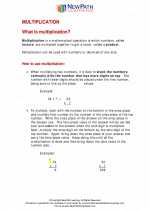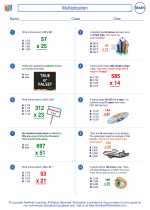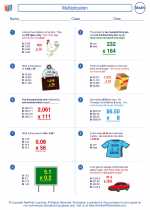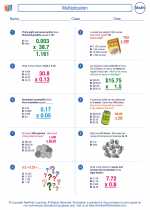Integers
Integers are whole numbers that can be positive, negative, or zero. They are represented on the number line as follows:
- Negative integers: ..., -3, -2, -1
- Zero: 0
- Positive integers: 1, 2, 3, ...
Operations with Integers
When performing operations with integers, there are a few rules to keep in mind:
- Addition: When adding integers with the same sign, add their absolute values and keep the sign. When adding integers with different signs, subtract the number with the smaller absolute value from the one with the larger absolute value and keep the sign of the number with the larger absolute value.
- Subtraction: To subtract an integer, add its opposite.
- Multiplication: When multiplying integers, if the signs are the same, the product is positive. If the signs are different, the product is negative.
- Division: When dividing integers, if the signs are the same, the quotient is positive. If the signs are different, the quotient is negative.
Absolute Value
The absolute value of an integer is its distance from zero on the number line. It is always a positive number.
Study Guide
Here are some key points to remember when studying integers:
- Know the definition of integers and be able to identify positive, negative, and zero integers.
- Understand the rules for addition, subtraction, multiplication, and division of integers.
- Practice finding the absolute value of integers and understand its significance in relation to the number line.
- Complete practice problems to reinforce your understanding of integers and their operations.
By mastering the concepts and rules related to integers, you will be well-prepared for more advanced topics in mathematics.
[Integers] Related Worksheets and Study Guides:
.◂Math Worksheets and Study Guides Sixth Grade. Multiplication
Study Guide Multiplication
Multiplication  Worksheet/Answer key
Worksheet/Answer key Multiplication
Multiplication  Worksheet/Answer key
Worksheet/Answer key Multiplication
Multiplication  Worksheet/Answer key
Worksheet/Answer key Multiplication
Multiplication 

 Worksheet/Answer key
Worksheet/Answer key
 Worksheet/Answer key
Worksheet/Answer key
 Worksheet/Answer key
Worksheet/Answer key

The resources above cover the following skills:
The Number System
Compute fluently with multi-digit numbers and find common factors and multiples.
Fluently multiply and divide multi-digit whole numbers using the standard algorithm. Express the remainder as a whole number, decimal, or simplified fraction; explain or justify your choice based on the context of the problem.